I set myself a challenge for this weekend – can I learn the shorthand method known as Teeline in a weekend?
News Associates claims it takes 6 weeks to learn the theory and 20 weeks to master. Is it then really possible to learn in a weekend?
The short answer? Yes.
The long answer? Functionally yes, but like any other skill it takes longer to master. The trick is to look for principles and work out what you actually need to learn.
What is Teeline?
Teeline is a shorthand writing system for rapidly writing English language notes. It has been a staple of the journalist skill box for a long time, though it is going out of fashion as recording and transcription tools take precedence.
It works by simplifying letter shapes, eliminating symbols and information which can be inferred, and creating further abbreviations of common words, phrases and word components. To the untrained eye, Teeline looks like the squiggles of a mad scientist. With even a weekend of practice, it looks like genius. The line between madness and genius is thin.
Take the Lord’s Prayer in Teeline as an example.
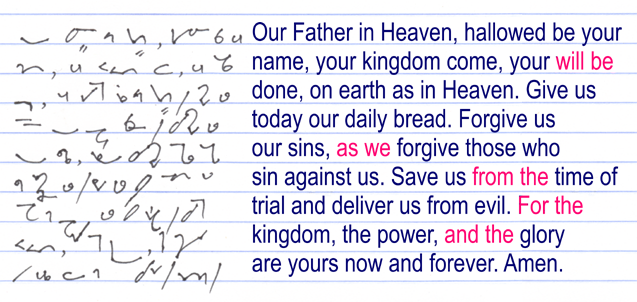
Source: Wikipedia Commons
On the right, we have the standard Lord’s Prayer. On the left, the same text written out in Teeline. They are exactly the same text, just written in a different form.
Immediately clear is how much less space it takes up on the page. Shapes are condensed. They seem to sprawl up and down the page. The shapes are clearly designed to flow, limiting how often the pen comes off the page.
Teeline achieves its brevity by simplifying shapes and abbreviating words. Here are some examples from the Lord’s Prayer in Teeline:

“Our” – the first word in the text is the indicator for the letter ‘O’ and nothing else. Very common words often have a shorthand-shorthand, in this case skipping the consonant altogether. The shape itself is meant to represent the curved bottom component of a longhand ‘O’, written so to ensure it is as fast to write as possible.

Next comes ‘Father’. This is written with the shorthand letters ‘F’ and ‘T’, and marked with two dashes below to indicate it is a proper noun. That’s it. All the vowels are dropped, and the ‘R’ at the end of ‘Father’ is omitted too as it is unvoiced.
This word has so much omitted that it highlights one of the trickier points of Teeline, and something that my 3 days of learning has not fully tackled – a lot of words fit into an ‘F,T’ outline: fit, fat, fate, fight (g is silent), Financial Times…short hand is context dependent.
In this case, the double dash helps – with a proper noun marker, it could only be the Financial Times in my list, and I was half joking about that one – there probably is a Shorthand standard for FT, but I don’t know it.

Finally, I have taken ‘Kingdom’ as an example as it beautifully shows another Teeline concept. This example you should take with a pinch of salt from me, as the following is an interpretation of what is going on rather confirmed reality.
If a standard abbreviation is part of another word, you can use that abbreviation within the outline. Here ![]() is the letter indicator ‘K’, which can also function as an abbreviation for ‘King’. (up to this point, I know this is true).
is the letter indicator ‘K’, which can also function as an abbreviation for ‘King’. (up to this point, I know this is true).
The next part, ![]() , covers the ‘dom’ in ‘kingdom’, The puzzle for me as a Teeline rookie is the dash at the start, a vowel indicator for the letter ‘I’. It would seem to refer to the ‘I’ in ‘King’, but the king is already represented by
, covers the ‘dom’ in ‘kingdom’, The puzzle for me as a Teeline rookie is the dash at the start, a vowel indicator for the letter ‘I’. It would seem to refer to the ‘I’ in ‘King’, but the king is already represented by ![]() .
.
In any case, this outline shows nicely how abbreviated shorthand mingles with fully written out shorthand. Very clever.
Why learn Teeline?
On the day I started learning Teeline, a journalist kindly told me that in her entire career she had used Teeline the grand total of zero times.
Good start.
These days it seems much more standard to record interviews and write up from sound files, or maybe even have transcription software do the heavy lifting for you.
Despite that, Teeline remains a part of journalist training programmes, seemingly a badge of honour on the way to becoming a fully-fledged reporter.
When recording is not possible, say for example in a court, a shorthand system still holds much value.
I haven’t attended any formal journalist training, teaching myself much of what I know. The UK standard, NCTJ, includes an optional module on Teeline. Having self-studied most of the course, Teeline was waiting to be delved into for the sake of completeness.
Shorthand certainly has an edge of mysticism about it. How English words can be decoded from those rapidly scrawled squiggles is a puzzle before you start learning how it works, some kind of sneaky journalist misdirection. Yet function it does.
Now that I have learned how Teeline functions, as a linguist I can draw fascinating comparisons with Arabic script and to a lesser extent even Chinese characters – something I explore in this article. For me, that makes Teeline worthwhile to learn, even if I never end up using the skill professionally.
Teeline in a weekend
My reference point for this learning journey was the textbook Teeline for Journalists by Dawn Johnston. I picked this book for the extremely in-depth and cultivated logic that it was available second hand for 2 quid. I have no idea whether it is the best book out there, but reviews that look genuine claim it is used on formal Teeline courses. Good enough for me – the book is for guidance, not dictation anyway.
This is what a weekend speed-learn of Teeline looked like:
Friday evening: I Speed-read the entire textbook and identify the key elements of the system. I had some questions to answer: What actually is it? What are the fundamental concepts of Teeline? What differentiates Teeline from normal writing? What enables Teeline to be written so fast? This was also the planning stage for Saturday and Sunday.
I ignored the book’s advice to work through each chapter in turn. Whenever a textbook asks you to read in order, ignore the advice – speed reading the whole book will give you an idea of what you actually need to study, and how to prioritise its content to your own needs.
Which section was the most valuable? The contents page. Even before opening the first chapter it was clear that Teeline was built on abbreviating and anticipating the most commonly used words in reporting.
Saturday morning: I learned the Teeline alphabet and played with creating words. At this stage this meant writing words in full and not joined, which are both incorrect practices. The point here however was to ingrain the base characters into my head, not immediately produce perfect shorthand.
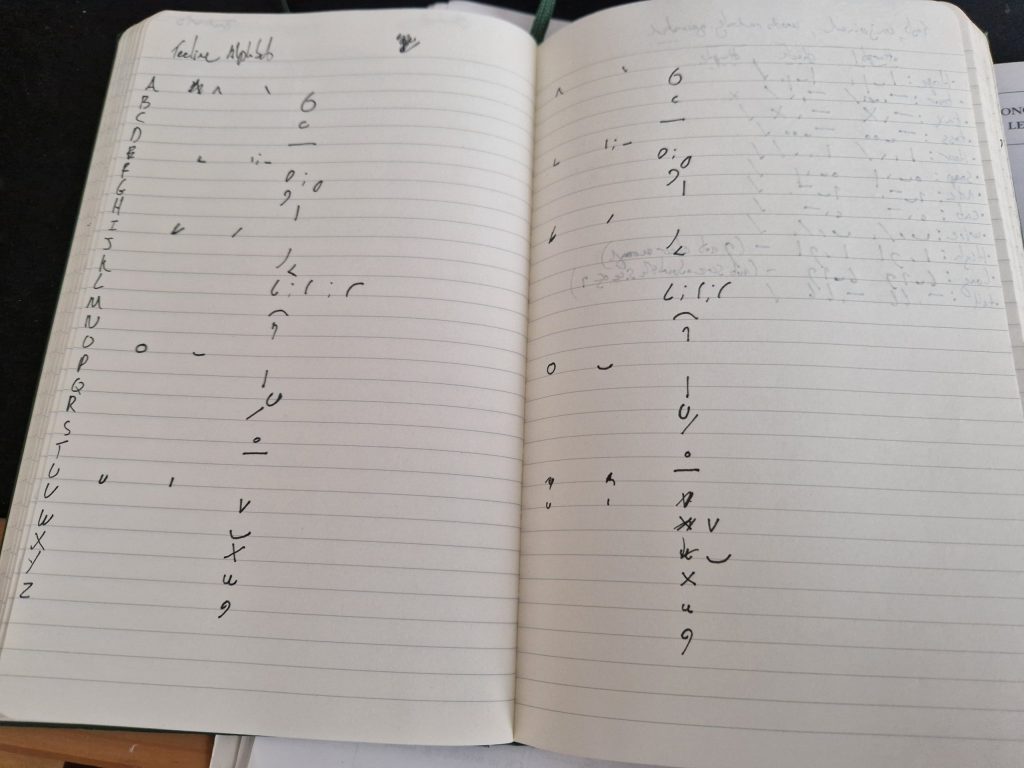
First notes on the Teeline alphabet, left side for notes, right side for recall.
It’s really important to emphasize that neither did I spend the whole of Friday evening with my eyes glued to the books, nor did I overwhelm myself with practice on the Saturday morning. This practice was done in short, focussed doses. Study for too long in one session and focus drops, making interest drop, and then nothing stays with the learner. Short, focussed learning.
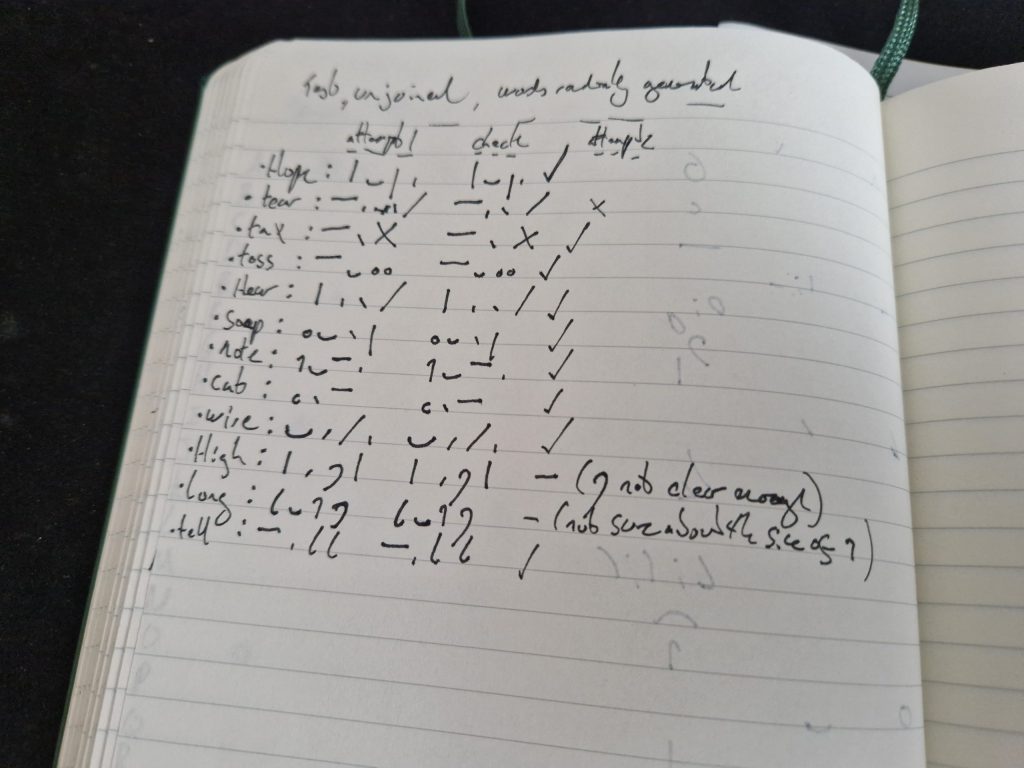
Practice words – incorrectly – written out in full
Saturday afternoon: The next stage was to learn how to join the letter indicators into full words. This is – in my view – the fun bit. Teeline is an abjad, meaning vowels are generally omitted. For those not familiar to the concept, Modern Arabic, Hebrew and Aramaic omit consonants from their scripts.
There are cases where Teeline does include the vowels, but in general they are left out. As long as you keep vowels at the start of words, Y shld fnd it is pssbl t undrstnd a lt of txt. Doing so also saves a tremendous amount of space and time.
At this point, I had -to a certain extent – learned Teeline. It was technically possible to produce any text in shorthand.
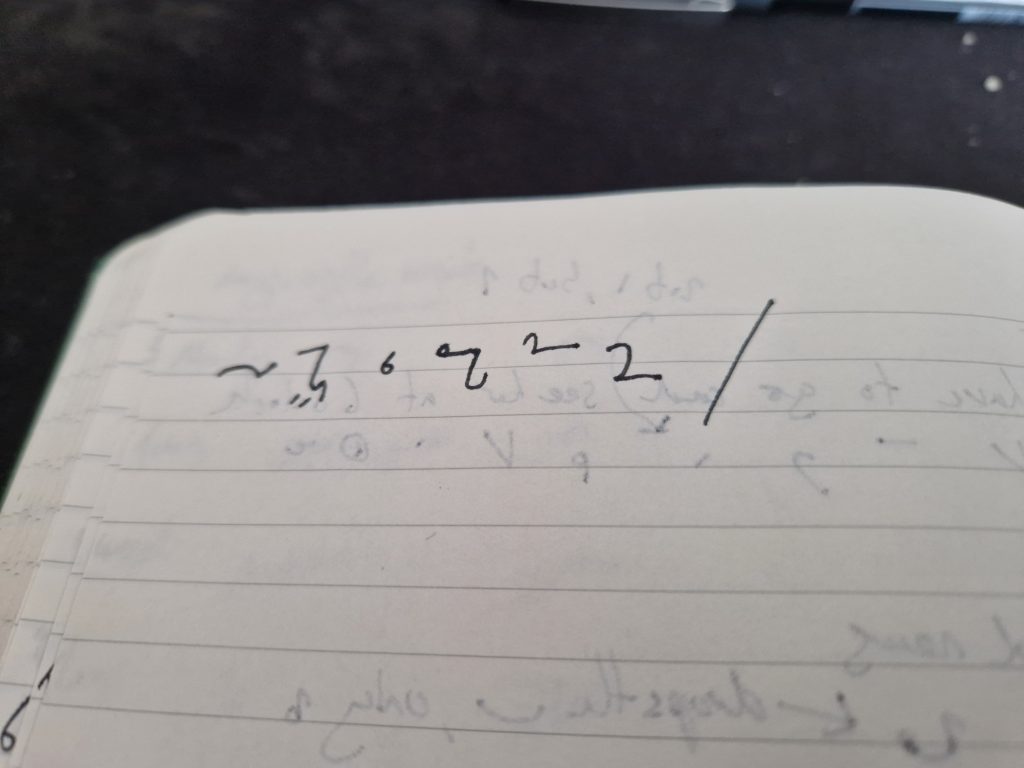
A confession to the Teeline readers out there.
That is however similar to claiming you have learned mathematics once you understand the four basic operators – technically most of what you do in maths will be variations of these tools, but their interactions become increasingly complex.
Sunday morning: The next step was therefore learning about details. The key aim of Teeline is to enable writers to produce notes rapidly, keeping up with speakers, holding their own in interviews, giving headroom to focus on all the other tasks the writer must achieve.
This is where abbreviations, or as Teeline for Journalists calls them, ‘special outlines’ come into play.
Often a lone letter can represent a word, or sometimes a grouping of letters omitting a few consonants along the usual neglected vowels. We do this already in standard written English – E.g. the phrase e.g. Company becomes Co. Laughing out loud becomes Lol. Etc.
From what I can tell, this is where the heavy lifting of serious Teeline study happens. As I hope I’ve shown in this article, it can take absolutely no time at all to learn the skeleton of the system. To make Teeline as effective as possible however requires mastering these ‘special outlines’ – something I couldn’t do in my weekend journey into the land of Teeline.
I got started though.
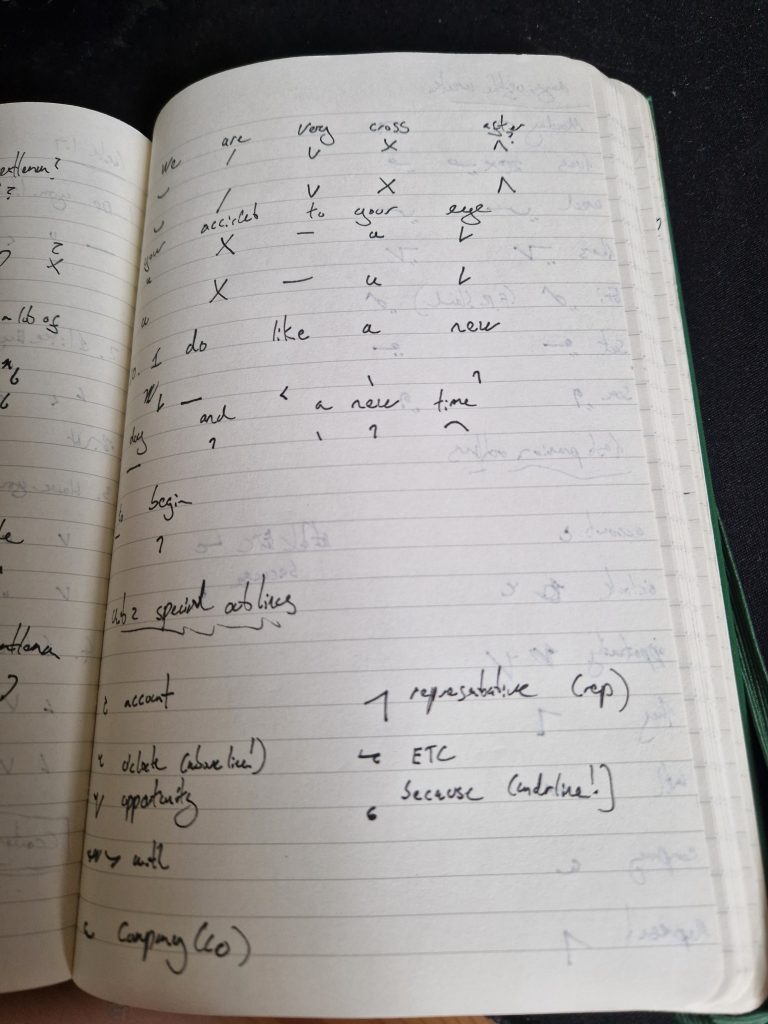
Running through Teeline for Journalists convoluted special outline drills
While it was straightforward to streamline learning the process for my Teeline foundation, I couldn’t immediately think of a clever focussed way for targeting the most useful abbreviations, so this was the point I just followed the book. As above shows, it is possible to write whole sentences using only standard abbreviated outlines, but I think in practice notetakers will need to spell out the occasional word properly.
Still, having learned about this final ingredient in the Teeline mix, I called victory on my weekend challenge – can you learn Teeline in a weekend? Yes you can!
(This is an AI-free article. My content is all-human written, unless stated otherwise.)
